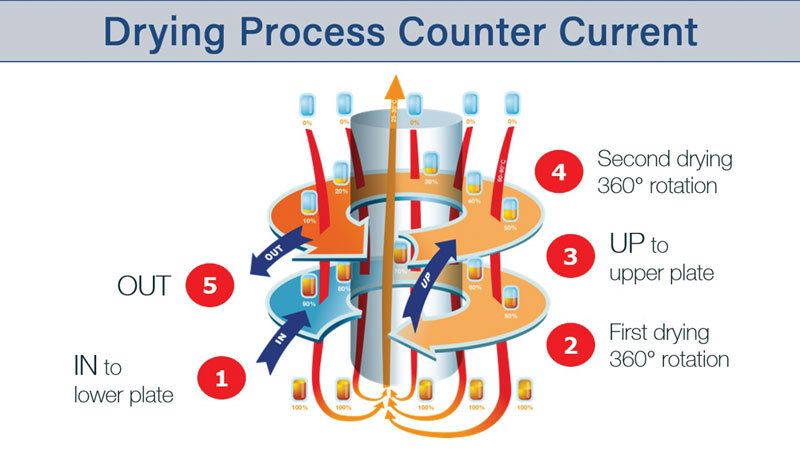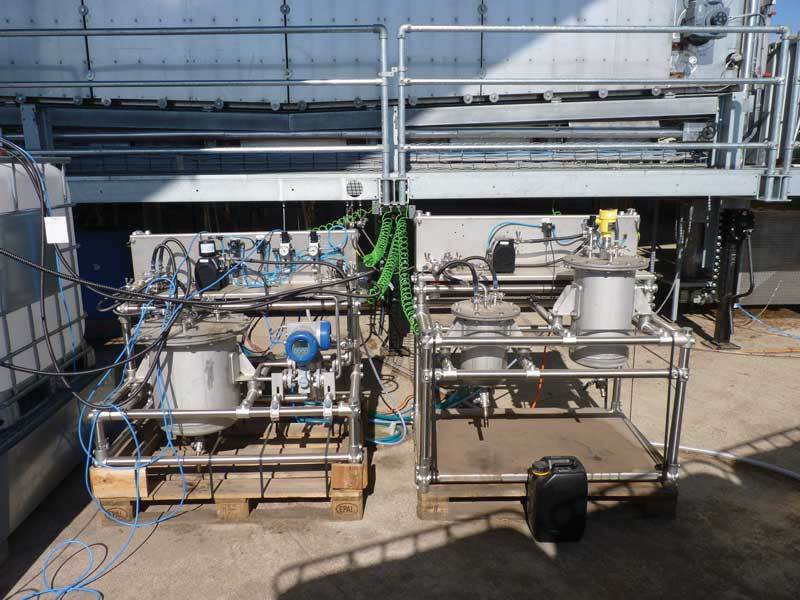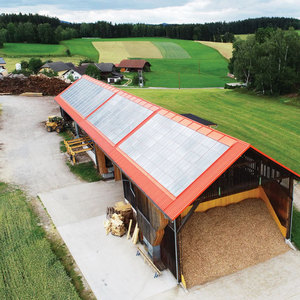A New Wave of Drying Techniques










PHOTO: CONA SOLAR
April 2, 2019
BY Patrick C. Miller
Around the world, industry is looking for clean, efficient and economical ways to dry wood chips for biomass heating. Whether it’s a multinational, high-tech research, development and demonstration project, a novel off-the-grid system based on solar energy or a unique dryer using low-temperature heat to remove as much moisture from wood chips as possible, there’s more than one way to dry a chip.
SteamBio is a recently completed project funded by the European Commission and supported by 11 partner organizations in four countries: Germany, Spain, Sweden and the U.K. Its objective is to create a commercially viable platform to stabilize biomass materials near their source for biochemical and bioenergy uses. The system uses super-heated steam in a controlled atmosphere to dry wood, making it more economical to ship from the remote forests where biomass fuel is often harvested before shipment to the cities where it’s used.
The project, which began in April 2016, was coordinated by the Fraunhofer Institute for Interfacial Engineering and Biotechnology IGB based in Stuttgart, Germany. A consortium was formed, which then applied for and received funding from the European Union’s Horizon 2020 innovation research program. The number and diversity of partners in the project provided skills ranging from end-user to all aspects of economy and sustainability.
Siegfried Egner, head of the physical process technologies department at Fraunhofer IGB, says SteamBio relies on the torrefaction process in which woody biomass is heated with steam at ambient pressure to a temperature above 392 degrees Fahrenheit. “The major challenge was the complexity,” he says. “We achieved a stable performance, including handling of the solid (self-igniting) and liquid (ATEX) products.”
As Egner explains the process, “Some light wood compounds get volatile and are captured with the surplus steam. The remaining solid is then easily ground due to the loss of the inner ‘glue.’ It is hydrophobic, so it can be stored in the open in rain and snow. It has higher temperature in an incineration boiler and represents a higher specific energy content per mass, which is important in the economics of long-distance transport. As the material is easily ground down to small sizes, it forms a highly reactive source for chemical use of the carbon source. This process has application to the wood pellet industry because the pellets can be formed and stabilized with the torrefaction process.”
A SteamBio demonstration unit was built by Heckmann Metall in Germany and commissioned in December 2017. It was then shipped to Duruelo de Sierra, Spain, in January 2018, and remained open to visitors until July 2018. The SteamBio continuous processing technology platform is scalable, and has been proven technically at industrial scales with temperatures above 572 degrees.
“The European Commission-funded project has finished, but further pilot plants representing the next generation are intended and planned,” Egner says. “We are open and ready for any cooperation with industry—in particular with companies that want to take a license to market the process after getting a knowledge transfer from us. Cooperation can be organized directly or via our legal entity in the U.S.”
On the other end of the temperature spectrum is the Dryer One drying system, designed and manufactured by Technic One in Thimister, Belgium. From the outside, a Dryer One unit could be mistaken for a large aluminum grain bin. According to Rashid Shakir, founder, president and applications engineer with Green Globe Services in Jessup, Maryland, one might need to get within 10 feet of the dryer to hear what’s going on inside it. Unlike conventional rotary drum drying systems that rely on high heat, people can work inside a Dryer One system while it’s operating.
Shakir, who’s spent 38 years in the biomass industry, first learned of Dryer One in 2013 while attending a trade show in Germany. He was looking for European technologies to bring to the U.S. through the company he founded in 2010. Technic One’s dryer technology was originally designed for a company handling various waste products from the baking industry and using a multitude of dryers to do it. Their method was costly, inefficient and labor intensive. Shakir was impressed that Technic One had designed and developed a single dryer that could handle all the products. The company now has four dryers in operation, two under construction and two more on the drawing board.
Shakir recognized that the technology also had the ability to dry biomass materials. “This is a very low-temperature dryer,” he says. “We are drying at almost half the temperature of the flash point of the dry wood—192 to 200 degrees air temperature. With conventional dryers, you are feeding hot air at 600 to 1,200 degrees. It takes a lot of fuel to heat 70-degree air to 1,000 degrees. You need a lot of thermal energy to do that.”
A Cure for Thermal Shock
When wood chips at an ambient temperature of 60 to 80 degrees are introduced into a drying chamber at high temperature, it subjects the product to thermal shock, according to Shakir. “A very fine layer of caramelization happens, which actually blocks the product from releasing the internal moisture to bring it out to evaporate,” he explains. “Also at this high temperature, you need a longer residence time and much tumbling. You need agitation. You need particle-to-particle friction. You have to have a lot of agitation in the system to get the moisture out.”
Another reaction at high temperature occurs when natural resins and oils evaporate from the wood, which Shakir says not only reduces the thermal energy of the wood chips, but also emits volatile organic compounds (VOCs) that must be captured to stay within air quality regulations. In a conventional dryer, tumbling and agitation of the wood chips result in dust and particulate matter that must be collected in a baghouse, cyclone or scrubber.
Within a Dryer One system are an upper and a lower circular plate upon which the wood chips rest as they rotate around a central column, providing an even drying process. The chips start on the lower plate and are then transported by a bucket elevator or worm drive to the upper plate where they rotate in the opposite direction. The heated air is drawn in from the bottom and circulated upward through the wood chips. Dried material is removed through the top of the dryer to the packaging area while moisture-laden warm air is ventilated out the top of the structure. “It’s a very slow operation,” Shakir says. “There’s no vibration, so you don’t need heavy-duty foundations. It’s a very quiet operation. When things don’t rumble or vibrate a lot, they can last a long time because there aren’t any deteriorating factors on mechanical elements. They can run many years without wearing down, lowering maintenance costs and increasing life expectancy.”
The advantages of the Dryer One system, Shakir notes, are greatly improved fire safety from low temperatures, an automated system that can be adjusted on the fly to provide the desired amount of moisture removal, wood chips of consistent quality with higher thermal energy value and no upfront investment for emission control systems. “If you have more control on consistency of your production, you have less waste and it costs you less thermal energy to dry it. All of this accumulates at the end for a better profit yield.”
Sun-dried Economics
If high-temperature steam and low-temperature air drying don’t fit the bill, then perhaps good old reliable solar energy is the answer. Located in Ried im Traunkreis, Austria, Cona Solar has more than 30 years of experience around the world in using the sun’s rays to dry everything from fruit to lumber. “The advantage is that the sun doesn’t send you a bill,” says Johanna Astecker, a company spokesperson. “You invest once in a solar drying system and in several years, it’s practically free. And your wood chips have a lot more calorific value—up to 60 percent more.”
Cona Solar might never have used its technology for drying wood chips if a company executive’s wife hadn’t asked him how it was that he could dry tea leaves and logs in remote regions of the planet, but not figure out how to dry the wood chips that fueled their home heating system. Today, Astecker says Cona Solar tailors each drying system it builds to fit a customer’s need, using the sun’s energy and a minimal amount of electricity to remove anywhere from 15 to 45 percent of the moisture from wood chips.
For anyone who thinks solar drying is limited to warm climates, Astecker says the system runs in Ireland, Ethiopia or Nicaragua. “We need a roof oriented toward the sun, but we can work with south, east and west roofs in the northern hemisphere,” she says. “In a region with less sun, we can use more sun collectors and get good drying results. We have areas in Austria with cold but clear days that dry a lot of material—even in the winter. Winter drying won’t work well in a region with a lot of fog. However, if the summers are more favorable, the yearly average might be the same.”
How effective is Cona Solar’s sun-powered drying technology? Astecker says a few years ago, the renowned University of Natural Resources and Life Sciences (BOKU) in Vienna was teaching students that biomass drying isn’t cost efficient. “They did several projects analyzing our systems and confirmed that it’s really economical and cost efficient,” she says. “Sizes with solar areas 24 square meters through 800 square meters all have the same efficiency.”
Whether it’s drying wood chips with high-tech steam, using unconventional low-temperature units or relying on the sun’s rays in hard-to-reach rural areas, the biomass industry is finding unique and innovative ways to get the job done.
Author: Patrick C. Miller
Staff Writer, Pellet Mill Magazine
701-738-4923
pmiller@bbiinternational.com
Advertisement
Advertisement
Upcoming Events





